European Audio Team, better known by the acronym E.A.T., is spearheaded by Ms. Jozefina Lichtenegger (herself married to Pro-Ject executive Heinz Lichtenegger), and principally builds turntables, tonearms, a tube-type amplifier and four different tubed phono preamplifiers. E.A.T. also markets three different private-labeled moving coil cartridges and a wooden headshell. They actually began in business as a manufacturer of vacuum tubes, which still today they make for their own purposes, supply to other manufacturers and sell to the public.
In what almost certainly must be a personal passion for Mrs. Lichtenegger, and most improbably for the stereotypical audio company, E.A.T. also sells art, jewelry, candles and perfume. Some of these non-audio products are designed by Ms. Lichtenegger or, at a minimum, she has a hand in their creation. There’s a link on the E.A.T. website for those products as well.
We’re here to discuss turntables, however, and while E.A.T. has gained a solid reputation in Europe, they are sadly not as well known in the United States. I suspect this oversight will change. Because if the level of craftmanship, level of performance, magnificence of design, understated visual elegance and relatively agreeable price in comparison to what the entire product line provides is not enough to gain a better foothold in the U.S., I cannot imagine what it would take to do so. I was fortunate enough to be offered the flagship E.A.T. Fortissimo Turntable with the optional F-Note Tonearm for review. What I discovered was not only a product with unassuming yet nonetheless elegant visual aesthetics, but also a turntable with exceptional performance and design excellence. Let’s take a closer look at this very impressive turntable.
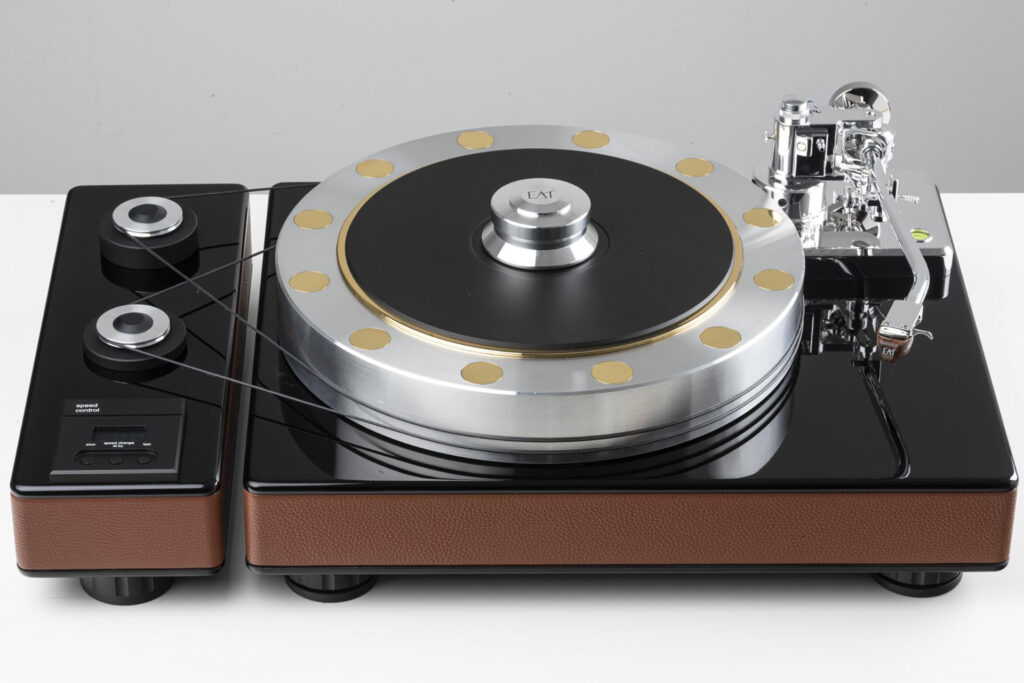
What Makes the E.A.T. Fortissimo Turntable So Special?
- There are multiple options for adorning the turntable base. My review sample was outfitted with a brown leather-wrapped base and highly polished black plinth. Having a variety of choices makes personalization an accommodating option. One must wonder if these customizations are due to Ms. Lichtenegger’s interest in art.
- The newly-designed base is specifically engineered to accommodate the turntable’s overall mass. Even the six fully-adjustable magnetic feet are made to work in concert with the significant weight of the turntable. Once the platter and cartridge have been installed, a thumbwheel on the feet may be adjusted to level the base and the motor housing. A bubble level on the F-Note tonearm provides visual confirmation. I also used a separate level in multiple locations on the turntable base prior to and after installing the platter to ascertain that everything was level.
- Whereas most turntable manufacturers use one motor and one rubber belt, E.A.T. uses two motors and two silicone belts. Primarily, two belts have a dual positive effect. One, two belts coupled with dual high torque, low noise motors reduces noise caused by vibration. And secondly, using two belts increases belt life.
- Weighing in all by itself at about 150 pounds, with almost 49 pounds allotted to the platter alone, mass is in abundant supply. I came to immediately appreciate this mass, since my system is on the second floor, and not once did the tonearm bounce when I walked around in the audio room.
- The platter consists of a harder alloy along its outer periphery, a softer alloy around the inner periphery, and Sorbothane dampening to reduce spurious resonances from being picked up and transmitted as distortion.
- E.A.T. does not stop there, however. Rather than using the standard 12 inch diameter platter, E. A. T. uses a 15.75 inch diameter platter fitted with 12 brass inserts spaced around the outer periphery. These inserts provide a two-fold accomplishment. One, this design has twice the inertia as a platter with equal mass with no increase in bearing load. Secondly, rumble and bearing load are proportional so a larger overall platter diameter with no additional weight yields improved dynamics and a lower overall noise floor. The central hub is also made from brass. On the bottom of the platter are a series of neodymium magnets, which serve to function in a quasi, mag-lev fashion. These magnets do not completely levitate the platter. Instead, they serve to reduce or, more specifically, offset the substantial platter mass on the inverted central bearing. This bearing, exclusive to the Fortissimo, is treated with a NASA-designed, extremely low-friction coating called Movic. And lastly, there is a ceramic ball with a Teflon plate on the bearing cup. If these features sound like design excellence is in abundance, you’d be correct. And this is only the platter.
- The AC motors are housed in a separate enclosure to provide reduced vibrational noise transmission. There is also a spacer provided in the accessories kit to ensure a precise 10mm spacing between the motor unit and the turntable base.
- Also on the motor enclosure are the power switch and fine speed adjustment. This is also where the selection of either 33.33 RPM or 45 RPM may be made. 78 RPM is not offered on the E.A.T. Fortissimo turntable. Precise calibration of the platter speed may also be made from the controls on the drive unit.
- While the standard supplied tonearm is the Unipivot C-Note version, the upgraded and impressively-designed, gimbaled F-Note Tonearm is optionally available. Both versions feature a 12-inch tonearm. However, the F-Note tonearm has options, such as being straight or S-shaped, satin black or polished aluminum arm tube, or a straight satin black wooden version. My review sample turntable was outfitted with the F-Note, 12-inch, highly-polished, straight aluminum arm tube.
- In addition to looking the part, the F-Note tonearm is also impressively designed. Mounting the arm board to the plinth is done by a substantial base, designed to prohibit vibrations from passing to the tonearm. It offers a two-stage Vertical Tracking (VTA) adjustment, one a macro modification and the second a micro version. Macro adjustments are made by loosening two set screws, adjusting the pillar height, and re-tightening the set screws. The micro version is done by a round adjustment knob on top of the pillar. Adjusting VTA on the fly might be a stretch, but effecting visually precise calibrations with no platter rotation is quite simple. While basically a gimbaled design, the tonearm’s azimuth is preset at the factory. However, it may be user-adjusted if so desired. My review sample needed no additional azimuth adjustments beyond the factory settings. There is a laser mounted on the pillar to verify correct adjustment of both the VTA and the azimuth. Both laser variations operate in essentially a go/no-go arrangement.
- Both the Micro VTA and azimuth are user-modifiable without the use of any tools. Precise calibrations of these settings are made by loosening and tightening hand-adjusted set screws. Many turntables require tools for these changes. That the F-Note does not is a very welcome feature.
- Counterweight modifications are made by adjusting the counterweight forwards or backwards along the tonearm until the tracking force is close to the desired setting.Precise adjustment may then be made by rotating the counterweight along its axis. The counterweight features a threaded shaft to facilitate highly accurate downforce calibration of the tonearm when the cartridge is mounted. Barely turning the counterweight on a threaded shaft is much easier, and far more precise, than sliding it back and forth on a non-threaded shaft by hand. The threaded shaft of the counterweight works independently of the set screw to secure it to the tonearm, thus allowing very precise downforce modifications.
- There is an antiskating adjustment made possible by sliding a counterweight based on the tracking force of the cartridge. Making this adjustment is simple and may be performed very quickly.
A Brief Note About Customization …
E.A.T. very conveniently offers a wide range of options for the Fortissimo turntable. It may, for instance, be ordered without a tonearm, should the user prefer their own. The standard tonearm is the Unipivot C-Note, and the upgraded version, with which my review sample was equipped, is the gimbaled F-Note tonearm. The standard turntable with the 12-inch C-Note tonearm with the piano black base retails for $13,999. Both a black and a natural brown leather-wrapped base are available, as well as a black, white or blue plinth. A plastic dust cover is also optionally available.
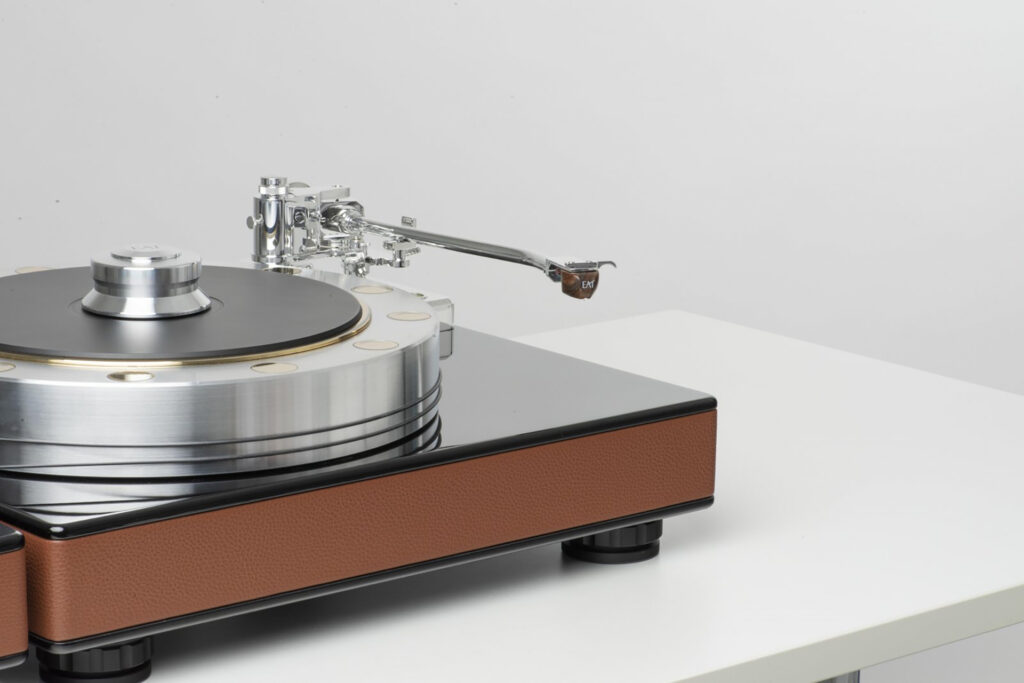
Why Should You Care About the E.A.T. Fortissimo Turntable?
To many vinyl enthusiasts, a turntable costing as much as the E.A.T. Fortissimo is undoubtedly, perhaps even prohibitively, expensive. But vinyl playback is a funny thing. While the basic philosophy of playing a record remains mostly unchanged, doing so in no way precludes technological advances. There are consumers who are willing to pay for technological innovations.
Given the substantial mass of this turntable, the separate motor assembly, and the superior attention given to all facets of the design, featuring engineering elements not typically found on turntables at this or perhaps even a much higher price point, the E.A.T. Fortissimo turntable is easily a diamond in the rough. I am not aware of many, if any, turntables competitively priced with the E.A.T. Fortissimo, with so much engineering excellence relative to the retail price. For anyone who desires a big bang for the buck, this turntable delivers.
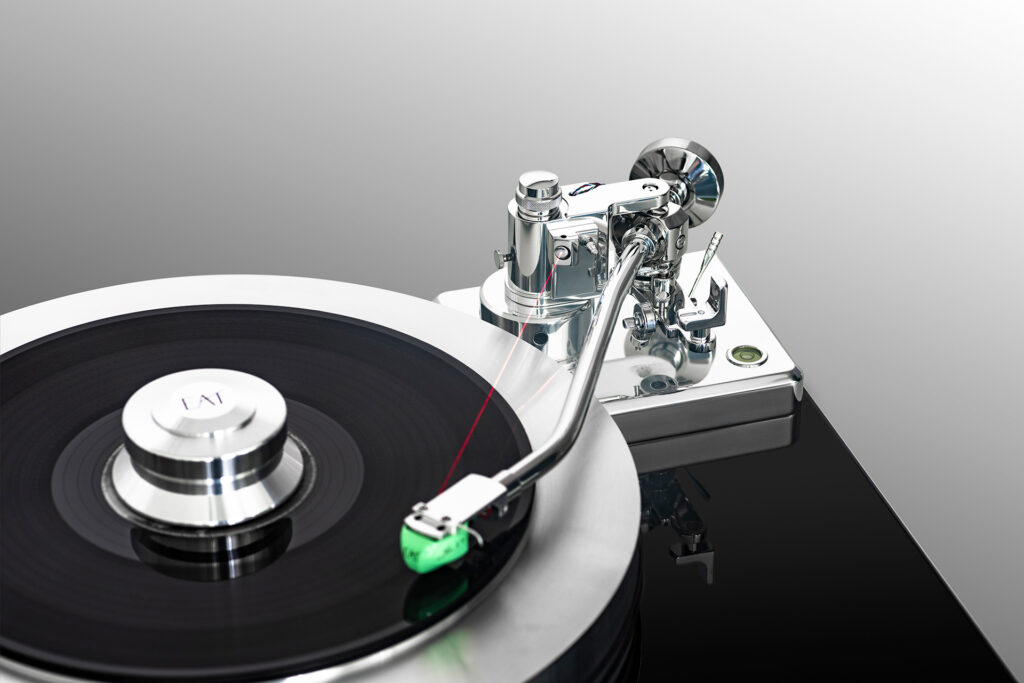
Some Things You Might Not Like About the E.A.T. Fortissimo Turntable …
- While significant turntable mass is a good thing, achieving it means a very heavy component. As it weighs nearly 150 pounds, careful planning must be given to where it is housed. Placing this turntable on a wall-mounted shelf should not take place unless the shelf is capable of supporting such a significant amount of weight. Lightweight audio racks should also not be used, unless the support of the weight of the E.A.T. Fortissimo, along with other components, can be confirmed.
- The total weight of the turntable makes it difficult to move. However, it can be moved in pieces. It took me five trips to get the complete turntable from the substantial and palletized shipping container (total weight of almost 200 pounds!) to my upstairs audio room. Yet the turntable was still very heavy, even in sections. Moving this turntable is much easier as a two-person job. I would be unable to move this large and heavy turntable as a single unit by myself.
- This is a large turntable in terms of overall size. It measures 28 inches from side to side, and 18 inches from front to back. Finding a home for a turntable this big, and this heavy, may be problematic for some. I also prefer to place my turntable on a vibrational absorption platform. Because my IsoAcoustics Delos platform is only 22 inches wide, I was unable to use it. A custom-made platform would be able to accommodate it, but I have not, as yet, found an off-the-shelf version capable of housing a 28-inch-wide turntable.
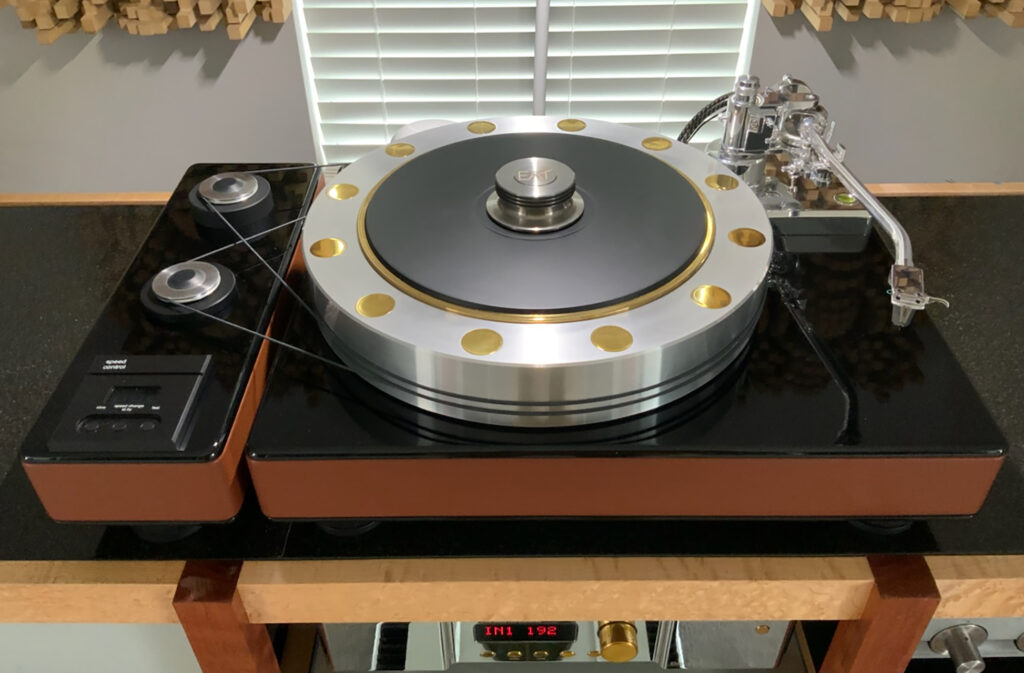
Listening With the E.A.T. Fortissimo Turntable
After getting the turntable set up and installing the cartridge, I was somewhat apprehensive about playing the first LP. I have previously had problems with a highly irritating ground loop hum. Happily, the E.A.T. Fortissimo was absolutely dead silent. It was a great start, to be sure. It would seem that the motor in a separate enclosure was doing its job. Of course, it took a certain amount of effort to dial in the subs, the VTA and the phonostage. Doing so probably took about 20 LPs, but I expected as much, so no problem. Once I felt like everything was properly set, I settled in for some serious listening. And boy, was I impressed. I first noticed an impressive bass response. Also, the Fortissimo is the first and only turntable I have ever had in my system with imaging completely on par with my digital section. I was able to hear a very impressive separation of instruments and specific placement of musicians on the soundstage. Clarity and accuracy were also very impressive and varied, depending on the recording quality.
On the somewhat rare, specially plated and pressed in 1973 by JVC in Japan, the MoFi original master recording of Elton John’s Goodbye Yellow Brick Road, the first track, “Funeral for a Friend/Love Lies Bleeding,” has always been a favorite. Starting out with Sir Elton playing softly on a piano, it soon adds a synthesizer and, when drummer Nigel Olsson comes in, the drum whack simply exploded – so much so that it surprised me, even though I knew it was there. I next noticed the impressive bass response. There was a palpable sense of low frequencies that could be heard, and to some degree, even felt. Davey Johnstone sizzled on guitar. Most extraordinary was the imaging. It ranked up there with a digital, HD-downloaded version of “Yellow Brick Road” that I have on my music server. All in all, very this very impressive track absolutely captivated me. I’m not really sure I have ever heard it sound better on my system.
My original 1970 version of Grand Funk Railroad – Closer to Home barely survived my college dorm room years, so I splurged a bit and ordered an Acoustic Sounds remastered version. Track nine, “I’m Your Captain (Closer to Home),” is a 10:09 amalgam of sometimes very energetic rock riffs, and other times lush orchestrations. Adding to the mix was Mark Farner’s anthem-like, yet also emotional vocal presentation, in which a sense of longing was often portrayed. With the E.A.T. Fortissimo, all of this was on full display. The progressive rock sections blended very well with the orchestration on the recording, and the Fortissimo was able to present both in an unmistakable and easily identifiable manner. Despite this being a remaster of a 55-year-old recording, I was pleasantly surprised at the overall sonics – especially the bass response. The imaging was easily in every way equal to the digital version I have on my music server. This long-ago work is quite timeless and, each time I play it on my system, I wonder why it had been so long since I heard it last. Maybe the Fortissimo and the Acoustic Sounds remaster will correct this oversight.
Will the E.A.T. Fortissimo Turntable Hold Its Value?
This is a somewhat difficult question to answer. First, E.A.T. as a company is not nearly as widespread in the U.S. as several of the more marquee brands – think VPI, Pro-Ject, Clearaudio, Technics and Rega, just to name a few. In no way does this diminish the excellence of the line’s build quality. Secondly, if the engineering advances of the Fortissimo based on its retail price are a sign of what this company can produce, I would say buying an E.A.T. Fortissimo turntable, or even one of the lesser-cost models, is a very safe prospect. At the time of writing this review, I only found one E.A.T. turntable for sale on the popular used gear sites, and it was not the Fortissimo. If E.A.T. is successful in gaining additional market penetration in the U.S., as I expect they will, purchasing the Fortissimo, or any of their turntables, should be a very safe bet.
What is the Competition For the E.A.T. Fortissimo Turntable?
VPI would be a good place to start, and the Avenger Plus ($18,000) is a candidate for comparison. At a not so insignificant 77 pounds, the three-layered platter, itself weighing 20 pounds, is designed as acrylic/aluminum/acrylic, and is also dampened for vibrational absorption. The Avenger Plus comes standard with VPI’s “Fatboy” 3D-printed tonearm, in a gimbaled design rather than the Unipivot version VPI used for so many years, and with Nordost wiring. It features an innovative belt/rim drive system mounted in a separate enclosure.
Priced at about $14,000, family connections notwithstanding, the Pro-Ject Signature 12 is not only visually elegant, but also a very popular model in the company’s turntable lineup. Featuring some of the design elements of the E.A.T. Fortissimo, such as an opposing magnetic suspension, a high-mass chassis and a mass-loaded plinth, Pro-Ject can supply this turntable in several different base colors. They also offer a walnut base in two different finishes. One difference is that Pro-Ject only supplies this turntable with a Unipivot tonearm, whereas E.A.T. has both Unipivot and a gimbaled tonearm design. Despite both company’s leaders being married to each other, E.A.T and Pro-Ject do not appear to complement each other’s product lineup to any appreciable degree. In fact, they would appear to function more as competitors than collaborators.
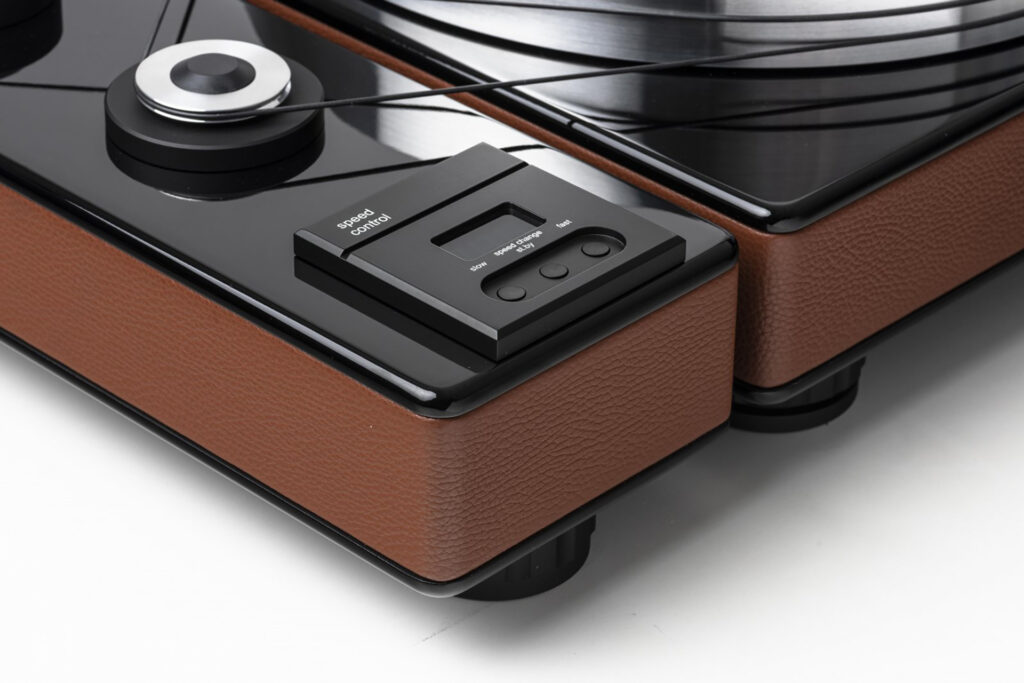
Final Thoughts About the E.A.T. Fortissimo Turntable …
E.A.T. offers the flagship Fortissimo turntable, outfitted in leather and a piano black gloss plinth, and the upgraded F-Note tonearm at a retail cost of $19,499. Given the level of engineering, design features, outstanding good looks and stellar performance, this price, while not in any universe considered budget, is lower than competitive models with less design excellence and fewer features. Of course, E.A.T. also markets, as contrast, the Prelude turntable for $1,195, and that price includes a cartridge and dust cover. This wide range of products and an overall modest price belies what the buyer may expect when purchasing an E.A.T. turntable. Regarding the Fortissimo, I cannot think of another turntable this massive, this finely appointed, and one with such performance and design excellence available at this price point. The E.A.T. Fortissimo is a standout product, which delivers sonic excellence worthy of a price several multiples of its cost.
I was overjoyed at the effortless musical portrayal, the dynamics, the bass response, the imaging and overall feeling of sonic enrapturement. It is one of very few turntables I’ve had in my system on which I felt I could listen to LPs all day. Yet it must also be understood that a turntable that retails for nearly $20,000 may well price itself out of many audiophile budgets. In the case of the E.A.T. Fortissimo, form follows function in a complete package, which offers the user features found on turntables significantly more expensive. When considering all this turntable has to offer, anyone considering a turntable in the $14,000 to $20,000 price category should look very closely at the E.A.T. Fortissimo.



